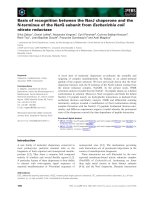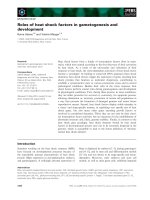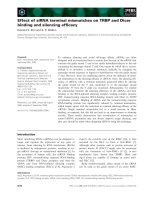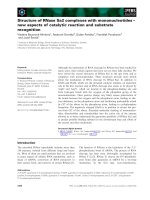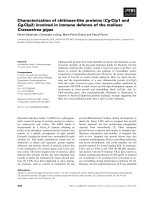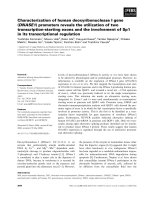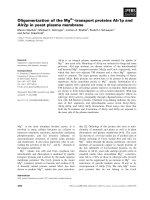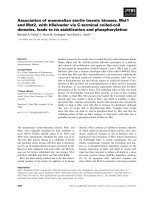Báo cáo khoa học: Reaction of human UMP-CMP kinase with natural and analog substrates docx
Bạn đang xem bản rút gọn của tài liệu. Xem và tải ngay bản đầy đủ của tài liệu tại đây (241.96 KB, 7 trang )
Reaction of human UMP-CMP kinase with natural
and analog substrates
Claudia Pasti
1,
*
,
†, Sarah Gallois-Montbrun
1,
†, He
´
le
`
ne Munier-Lehmann
2
, Michel Veron
1
, Anne-Marie Gilles
2
and Dominique Deville-Bonne
1
1
Unite
´
de Re
´
gulation Enzymatique des Activite
´
s Cellulaires and
2
Laboratoire de Chimie Structurale des Macromole
´
cules,
CNRS URA 2185, Institut Pasteur, Paris, France
UMP-CMP kinase catalyses an important step in the
phosphorylation of UTP, CTP and dCTP. It is also involved
in the necessary phosphorylation by cellular kinases of
nucleoside analogs used in antiviral therapies. The reactivity
of human UMP-CMP kinase towards natural substrates
and nucleotide analogs was reexamined. The expression of
the recombinant enzyme and conditions for stability of the
enzyme were improved. Substrate inhibition was observed
for UMP and CMP at concentrations higher than 0.2 m
M
,
but not for dCMP. The antiviral analog
L
-3TCMP was
found to be an efficient substrate phosphorylated into
L
-3TCDP by human UMP-CMP kinase. However, in the
reverse reaction, the enzyme did not catalyse the addition of
the third phosphate to
L
-3TCDP, which was rather an
inhibitor. By molecular modelling,
L
-3TCMP was built in
theactivesiteoftheenzymefromDictyostelium.Human
UMP-CMP kinase has a relaxed enantiospecificity for the
nucleoside monophosphate acceptor site, but it is restricted
to
D
-nucleotides at the donor site.
Keywords: UMP-CMP kinase; antiviral analog; 3TC; AraC;
phosphorylation.
Nucleoside analogs constitute a familly of important
antiviral and anticancer drugs. Analogs of thymidine like
AZT (2¢3¢-deoxy-3¢azido thymidine), d4T (2¢3¢-dideoxy-2¢3¢-
didehydro-thymidine) have been used to treat HIV infection
for a number of years as well as analogs with an
L
-conformation in the sugar like
L
-3TC. All of these analogs
are delivered as nucleosides to the patients and need to be
phosphorylated within cells in order to be active on their
viral or cellular target. UMP-CMP kinase catalyses the
reversible transfer of phosphate between UMP (or CMP)
and ATP in the presence of magnesium ions according to
the following reaction:
UMP þ ATP-Mg
2þ
!
UDP þ ADP-Mg
2þ
The enzyme is involved in both the de novo and the salvage
pathway of nucleosides. It catalyses a compulsory step for
the synthesis of UTP, CTP and dCTP, that are incorporated
into nucleic acids. UMP-CMP kinase is therefore also
involved in the activation of nucleoside analogs and its
kinetic properties are important for the efficacy and the
selectivity of these drugs. The UMP-CMP kinase of several
eukaryotic organisms has been studied including yeast [1],
the slime mold Dictyostelium discoideum [2,3] and, recently,
in man [4]. The UMP-CMP kinase mRNA was ubiqui-
tously present in human tissues with highest levels in
pancreas, muscle and liver [4]. The enzyme belongs to the
large family of eukaryotic nucleoside and NMP kinases for
which AMP kinase is a prototype [5,6]. In contrast, in
prokaryotes and, in particular in E. coli, UMP kinase and
CMP kinase are different proteins sharing no sequence
similarity [7,8]. The 3D structure of UMP-CMP kinase
from the Saccharomyces cerevisiae [9] and from D. discoid-
eum [3] have been solved by X-ray crystallography and
compared to the structure of yeast S. cerevisiae adenylate
kinase [10]. All NMP kinases are globular proteins with a
Ôcore domainÕ made of a five-stranded parallel b-sheet
surrounded by eight helices. The protein is made of two
subdomains, each containing a nucleotide binding site. The
site for the nucleotide donor of phosphate (in general ATP)
presents a typical ÔP-loopÕ and a Ôlid domainÕ that closes
down over the active site during the catalytic cycle. The
protein, which is flexible as several structural changes occur
upon ligand binding, moves from an ÔopenÕ to a ÔclosedÕ
conformation during the catalytic cycle [10].
UMP-CMP kinase is involved in the phosphorylation
of several anticancer and antiviral drugs that are given
to patients suffering from AIDS and B hepatitis.
Correspondence to D. Deville-Bonne, Institut Pasteur, Unite
´
de
Re
´
gulation Enzymatique des Activite
´
s Cellulaires, 25, rue du Dr Roux,
75724 Paris Cedex 15, France.
Fax: + 33 1 45 68 83 99, Tel.: + 33 1 40 61 35 35,
E-mail:
Abbreviations: AraC, cytosine
D
-arabinofuranoside; AZT, 2¢,3¢-deoxy-
3¢-azido thymidine; GST, glutathione S-transferase; dCK, deoxycyti-
dine kinase;
L
-dC, b-
L
-2¢-deoxcytidine; d4T, 2¢3¢-dideoxy-2¢3¢-
didehydro-thymidine;
L
-dT, b-
L
-2¢-deoxythymidine;
L
-3TC,
b-
L
-2¢,3¢-dideoxy-3¢-thiacytidine;
L
-3TCMP, b-
L
-2¢,3¢-dideoxy-3¢-thi-
acytidine monophosphate;
L
-3TCDP, b-
L
-2¢,3¢-dideoxy-3¢-thiacyti-
dine diphosphate;
L
-3TCTP, b-
L
-2¢,3¢-dideoxy-3¢-thiacytidine
triphosphate; NMP, nucleoside monophosphate; NDP, nucleoside
diphosphate; NTP, nucleoside triphosphate.
Enzyme: Human UMP-CMP kinase (EC 2.7.4.14).
*Present address:UniversitadegliStudidiFerrara,Dip.Biochimicae
Biologia Molecolare,Via Borsari, 46, 44100 Ferrara, Italy.
Note: Both authors contributed equally to this work.
(Received 18 December 2002, revised 19 February 2003,
accepted 25 February 2003)
Eur. J. Biochem. 270, 1784–1790 (2003) Ó FEBS 2003 doi:10.1046/j.1432-1033.2003.03537.x
Arabinofuranosylcytocine (AraC) has a hydroxyl group in
the trans configuration at the 2¢-position of the sugar. b-
L
-2¢-
deoxynucleosides were shown to inhibit specifically hepatitis
B replication, along with b-
L
-thymidine (
L
-dT) and b-
L
-
deoxycytidine (
L
-dC) which are the most potent inhibitors
[11]. b-
L
-NTP and b-
D
-NTP are enantiomers resulting from
the asymmetry of the C4¢ and C1¢ of the ribose.
L
-cytidine
analogs used in therapies are substrates of deoxycytosine
kinase. This enyzme, which adds the first phosphate to
cytidine derivatives with variable sugar structures, has a low
enantioselectivity although it generally favors the
D
-enantio-
mer [12]. Human UMP/CMP kinase was recently shown
to phosphorylate monophosphate derivatives of deoxycyti-
dine analogs in either the
L
-or
D
- conformers [13]. The third
phosphate addition to
L
-cytidine analogs is catalysed by
phosphoglycerate kinase [14] but not by NDP kinase, which
reacts only with
D
-nucleotide analogs [15]. Another NMP
kinase, AMP kinase also called myokinase, was reported to
complement NDP kinase deficiency in E. coli upon gene
disruption [16]. AMP kinase catalyses the reversible ATP-
dependent synthesis of ADP from AMP. Therefore the
reverse reaction forms ATP and AMP from two ADP
molecules. We ask the question whether UMP-CMP kinase
also allows the addition of the third phosphate to analog
diphosphate substrates in the reverse reaction. We analyze
here the specificity of human UMP-CMP kinase for
different substrates including
L
-3TCMP in the forward
and backward reactions.
Materials and methods
Chemicals
All nucleotides were purchased from Sigma chemicals
(St Louis, MO, USA).
L
-3TC was extracted from EpivirÒ
tablets (GlaxoWellcome) with methanol. After purification
by silica gel column chromatography (dichloromethane/
methanol, 95 : 5, v/v), the nucleoside was phosphorylated
into the 5¢-monophosphate by overnight incubation at
20 °C with GTP in the presence of deoxyadenosine-
deoxycytidine kinase from Bacillus subtilis (a kind gift
of J. Neuhard, University of Copenhagen, Denmark).
L
-3TCMP was purified by successive chromatography on a
G-10 column (240 mL total volume) in water and by reverse
phase on RP-18 silica gel (50 mL). The purity of
L
-3TCMP
was characterized by nuclear magnetic resonance (
1
H,
31
P)
spectroscopy and mass spectrometry.
Cloning of the gene coding for UMP-CMP kinase,
expression and purification of His-tagged
UMP-CMP kinase
The 588-bp fragment corresponding to the gene coding for
the human UMP-CMP kinase was amplified by PCR [17]
using cDNA from SK melanoma cells as the matrix. The
two synthetic oligonucleotides used for amplification were:
5¢-GGAATTCCATATGAAGCCGCTGGTCGTGTTC
GTCCTCGGCGGCCCCGGCGCCGGCAAGGGGA
CC-3¢ and 5¢-CCGCTCGAGTTAGCCTTCCTTGTCA
AAAATCTG-3¢. During amplification, NdeIandXhoI
restriction sites (in bold letters in the oligonucleotide
sequences) were created at both ends of the amplified
fragment. After digestion by NdeIandXhoI, the
amplified gene was inserted into the pET28a plasmid
(Novagen, Inc.) digested with the same enzymes. Two
clones containing the gene coding for the human UMP-
CMP kinase and overexpressing the human UMP-CMP
kinase with a His-tag at the N-terminal part were
characterized. One of them was kept for further studies
and the corresponding plasmid named pHL60-5. The
DNA insert was sequenced [18] in order to verify the
absence of any mutational events in the course of
amplification.
BL21 (DE3)/pDIA17 E. coli strain [19] transformed with
pHL60-5 plasmid was grown in 2YT medium [17] contain-
ing 30 lgÆmL
)1
chloramphenicol and 70 lgÆmL
)1
kana-
mycine until D
600
¼ 1. After induction with 1 m
M
isopropyl
thio-b-
D
-galactoside and growth for 3 h at 30 °C, cells were
harvested, resuspended in 40 mL lysis phosphate buffer
50 m
M
pH 8 containing 300 m
M
NaCl, 10 m
M
imidazole,
protease inhibitors (Complete EDTA-free, Roche) and
1m
M
dithiothreitol and kept at )80 °C. Cells were broken
in a French Press at 100 Mpa and centrifuged for 30 min at
12 000 g at 4 °C. The supernatant was added onto a 20-mL
Ni-nitrilotriacetic acid column (Qiagen, Germany) preequili-
brated with lysis buffer. The column was washed with lysis
buffer (100 mL). The protein was then eluted by a linear
imidazole gradient (10–250 m
M
) pH 8.0. Fractions contain-
ing the enzymatic activity were pooled and dialyzed against
Tris/HCl 50 m
M
pH 7.5 containing 20 m
M
NaCl, 1 m
M
dithiothreitol and 50% glycerol and then kept at )20 °C.
The protein was > 99% pure as judged by SDS/PAGE on
15% acrylamide gels (Biorad).
The homogeneity of the enzyme preparation was meas-
ured by dynamic light scattering experiments using a
Dynapro-800 instrument (Proteinsolutions). The protein
was > 99.6% monomer with a hydrodynamic radius of
2.2 nm and a molecular mass estimated as 22 000. The
Stokes radius was measured by gel filtration on a Superdex
75H 10/30 (Amersham Biosciences) in Tris/HCl 50 m
M
,
pH 7.5 containing 200 m
M
KCl and 1 m
M
dithiothreitol,
using bovine albumin, ovalbumin and chymotrypsinogen as
markers. The elution volume of UMP-CMP kinase indica-
ted a Stokes radius of 2.8 nm, in agreement with a monomer
species.
Expression and purification of human UMP-CMP kinase
as a fusion protein with GST
BL21 gold (DE3) E. coli cells (Stratagene) were transformed
with the plasmid umpk-pGEX5X, a kind gift from A. Kar-
lsson (Karolinska Institute, Stockholm, Sweden), coding for
a fusion protein with the GST at the N-terminus of UMP-
CMP kinase [4]. Cells were grown in 2YT medium [17]
containing ampicillin 100 lgÆmL
)1
until D
600
¼ 0.4. After
induction with 1 m
M
isopropyl thio-b-
D
-galactoside and
growth for 5 h at 22 °C, cells were harvested, washed once
in 100 m
M
Tris/HCl pH 8 containing 10 m
M
MgCl
2
and
1m
M
dithiothreitol, resuspended in 50 m
M
Tris/HCl pH 8
containing 1 m
M
EDTA, 5 m
M
MgCl
2
,5m
M
KCl, 1 m
M
dithiothreitol and 0.5 m
M
phenylmethanesulfonyl fluoride
and kept at )80 °C. The cells were broken as indicated
above, centrifuged for 30 min at 12 000 g and the super-
natant was incubated with glutathione-agarose for 1 h at
Ó FEBS 2003 Substrate specificity of human and Dictyostelium UMP-CMP kinase (Eur. J. Biochem. 270) 1785
4 °C according to the Amersham Biosciences procedure.
The gel was poured into a column and washed with
phosphate buffer 100 m
M
pH 7.4 containing 100 m
M
NaCl,
1m
M
EDTA and 1 m
M
phenylmethanesulfonyl fluoride.
The fusion protein was eluted by phosphate buffer 100 m
M
pH 7.4 containing 100 m
M
NaCl, 5 m
M
MgCl
2
and 10 m
M
glutathione. The fractions containing UMP-CMP kinase
activity were pooled; glycerol was added to a 20% final
concentration and kept at )20 °C. The protein was
found 95% pure by SDS/PAGE on 15% acrylamide gels
(Biorad). No loss in activity was observed after 2 months.
The typical yield was 10 mg pure fusion protein per litre of
culture.
Expression and purification of
Dictyostelium
UMP-CMP
kinase
Plasmid pIMS5, a kind gift from L. Wiesmu
¨
ller (University
of Hamburg, Germany), was expressed in XL
1
Blue E. coli
strain in Luria Broth. After growth at 37 °CtoD
600
¼ 0.5,
isopropyl b-
D
-thiogalactoside (0.5 m
M
) induction was car-
ried out for 4 h at 22 °C. After centrifugation, cells were
resuspended in 50 m
M
Tris/HCl buffer pH 7.4 containing
1m
M
EDTA and 2 m
M
dithiothreitol (buffer A). The cells
were sonicated (3 · 2 min) and centrifuged (17 000 g,
30 min). The supernatant was applied onto a Blue-Seph-
arose column (Amersham Biosciences) (100 mg protein for
6 mL of gel), washed with 50 mL of buffer A and 10 mL of
buffer A containing 0.3
M
NaCl, before elution of the
protein with buffer A containing 1
M
NaCl. Further
purification by gel filtration chromatography (Ultrogel
AcA 54, Sigma) in buffer A without dithiothreitol resulted
in pure enzyme. It was stored at )20 °C in 20% glycerol.
Enzymatic activity of UMP-CMP kinase
The forward reaction of UMP-CMP kinase was followed in
a spectrophotometer by measuring ADP formation as
described [20] in the presence of dithiothreitol [4,13,21]. The
assay contained 50 m
M
Tris/HCl pH 7.4, 50 m
M
KCl,
5m
M
MgCl
2
,1m
M
ATP, 0.2 m
M
NADH, 10 m
M
dithio-
threitol, 1 m
M
phosphoenolpyruvate, 1 m
M
ATP and the
auxiliary enzymes: pyruvate kinase (4 U), lactate dehydro-
genase (4 U) and NDP kinase from Dictyostelium (4 U). In
the case of
L
-3TCMP as substrate, no NDP kinase was
added, as
L
-3TCDP is not a substrate for this enzyme [15].
The reaction was started at 37 °C by addition of 1 m
M
dCMP or another phosphate acceptor (1 m
M
)andenzyme
(final concentration 8.4 lgÆmL
)1
¼ 0.17 l
M
). In order to
avoid limitation by the coupled system, the rates were below
0.2 units at A
340
per min. The rate was calculated assuming
that two ADP are generated during the reaction (due to the
presence of NDP kinase), except when
L
-3TCMP was the
phosphoacceptor where only one ADP was produced.
Curve-fit was performed using
KALEIDAGRAPH
(Abelbeck
Software) for a hyperbolic progress equation unless indica-
ted. Alternatively the enzyme-coupled assay was automated
in 96-wells microplates in 250 lL final volume with four
times less enzyme and the reactions were monitored during
10 min on a microplate reader (BIO-TEK Elx808). The
reaction rates were calculated using the
KC4
software (BIO-
TEK Instruments, USA).
The reverse reaction catalysed by the human UMP-
CMP kinase was assayed with [
3
H]CDP (Amersham
Biosciences) and CDP, dCDP or
L
-3TCDP as substrates.
The formation of dCTP (or
L
-3TCTP) catalysed by UMP-
CMP kinase was studied under steady state conditions.
The amount of [
3
H]CMP and [
3
H]CTP formed in the
presence of 1 m
M
[5-
3
H]CDP (0.2 CiÆmmol
)1
) and 0.25–
2m
M
of dCDP or
L
-3TCDP was monitored for 2, 4 and
6 min. The assays were started by adding the enzyme
(final concentration 8.4 lgÆmL
)1
¼ 0.17 l
M
)toareaction
mixture (15 lL) containing 50 m
M
Tris/HCl pH 7.5,
5m
M
MgCl
2
and the substrates at 37 °C. The reaction
was stopped at 2, 4 and 6 min by adding 3 lL aliquots
of the reaction mixture to 2 lL stop solution consisting
of 1 m
M
formic acid and 10 m
M
each of CDP and CTP.
Radioactive CMP, CDP and CTP were separated on
TLC aluminum sheets (Silica gel 60 F
254
,Merck),which
were developed with isopropanol/NH
3
30%/H
2
O,
3 : 1 : 1, v/v/v. After drying, the plates were counted on
a BETA-Imager 2000 counter (Biospace, Paris, France)
[21] and analyzed. As [
3
H]CMP was made in parallel in
the reaction from two [
3
H]CDP molecules, the corres-
ponding background was subtracted from the results
obtained in the presence of dCDP or
L
-3TCDP.
Results
Analysis of the forward reaction catalysed
by UMP-CMP kinase with natural substrates
and nucleoside analogs
The purified recombinant human UMP-CMP kinase
expressed as a His-tag fusion was analyzed by dynamic
light scattering and gel filtration on Superdex 75, yielding an
hydrodynamic radius of 2.2 nm and 2.8 nm, respectively
(results not shown). This corresponded to a monomeric
state of the protein. Figure 1A and Table 1 show the
activity of human UMP-CMP kinase as a function of
natural substrates, and the corresponding kinetic param-
eters. The reaction rates were found to increase as a function
of UMP and CMP as expected for Michaelis curves, but did
not reach a plateau (the maximum rate V) due to substrate
inhibition at concentrations above 0.2 m
M
. The correpond-
ing inhibition constants K
i
were 0.5 m
M
for CMP and
1.5 m
M
for UMP, with K
m
values of 22 l
M
and 44 l
M
,
respectively. In contrast, no excess substrate inhibition was
foundwithdCMP(K
m
¼ 0.9 m
M
), indicating that the
presence of the 2¢OH of the ribose is presumably involved in
the inhibition mechanism. Both UMP and CMP were found
to be better substrates than dCMP with smaller K
m
and
higher V, resulting in considerably improved catalytic
efficiencies (k
cat
/K
m
). These data were found for concentra-
tions of 5 m
M
Mg
2+
ions and above.
The substrate specificity of the His-tagged enzyme was
investigated by assaying a series of nucleoside monophos-
phates: AMP was found to be a slow substrate with K
m
higher than 5 m
M
and a catalytic efficiency about
1000
M
)1
Æs
)1
while dTMP and GMP were not substrates
(k
cat
/K
m
< 100
M
)1
Æs
)1
) (not shown). The activity of
human UMP-CMP kinase was then analyzed using nucleo-
side analogs as substrates. As shown in Fig. 1B, (
L
)-3TCMP
and AraCMP were substrates with K
m
in the 0.2 m
M
range.
1786 C. Pasti et al. (Eur. J. Biochem. 270) Ó FEBS 2003
No inhibition by excess of substrate was detected. The
turnover number for AraCMP was similar to that of UMP
(around about 150 s
)1
) and it was significantly lower for
L
-3TCMP (36 s
)1
) (Table 1). According to catalytic effi-
ciencies, NMPs fall in two groups with catalytic efficiencies
intherangeof10
7
M
)1
Æs
)1
for UMP and CMP, and of
10
5
M
)1
Æs
)1
for AraCMP,
L
-3TCMP and dCMP (Table 1).
Careful characterization of the reaction catalysed by
human UMP-CMP kinase indicated that the type of fusion
protein made for purification purposes could interfere with
the kinetic properties of the enzyme. Thus, when expressed
as a GST fusion, the kinetic parameters of human UMP-
CMP kinase were different from those of the His-tagged
fusion protein. As shown in Table 2, the catalytic efficiencies
calculated from K
m
and k
cat
for both natural substrates or
analogs resulted in an average fivefold decrease in catalytic
efficiencies as compared to the His-tagged enzyme shown in
Table 1. As NMP kinases are very flexible proteins [10], this
decrease in activity with the GST-fusion enzyme is likely to
correspond to a decrease in the protein dynamics due to the
presence of the bulky additional GST domain.
We also compared the kinetic properties of the human
UMP-CMP kinase with those of the enzyme from Dicty-
ostelium whose tertiary structure was determined by X-ray
crystallography [3] (Table 3). Although both proteins show
50% sequence identity, several differences in the kinetic
properties were observed (Table 3). For natural substrates
(UMP and CMP), no inhibition by substrate excess is
found. While the turnover is increased for the Dictyostelium
enzyme by two fold, a decrease in catalytic efficiencies from
10
7
M
)1
Æs
)1
for human UMP-CMP kinase to 10
6
M
)1
Æs
)1
is
observed for the Dictyostelium enzyme. Table 3 shows that
Dictyostelium UMP-CMP kinase also accepts
L
-3TCMP as
substrate, although it reacts with the analog about 500 times
less than the human enzyme.
The Dictyostelium enzyme seemed a more appropriate
structural model for the human enzyme [3,22] than the
protein from yeast, which differs significantly in specificity
since it also reacts with adenosine [23,24]. The structure of
Dictyostelium UMP-CMP kinase has been determined as a
complex with ATP, CMP as well as with AlF
3
(PDB
accession no. 3UKD), providing a model for the active
state, as aluminum fluoride resembles a transition state of a
phosphoryl transfer reaction [22]. Figure 2 shows a model in
which CMP was replaced by
L
-3TCMP in the acceptor site
of Dictyostelium UMP-CMP kinase. Starting from the
superimposition of the a-phosphates, the oxathiolan ring of
L
-3TCMP could fit over the CMP ribose. This results in a
translation of the cytosine ring of about 1.2 A
˚
. This shift
seems to be easily tolerated by the binding site, due to the
absence of direct interactions between the base moiety and
the side chains of the enzyme [3]. In conclusion,
L
-3TCMP
can be modeled into the CMP binding site of UPM-CMP
Fig. 1. Measure of the steady-state kinetics parameters of human UMP-
CMP kinase. (A) Kinetic for natural substrates UMP, CMP, dCMP.
(B) Kinetic for substrate analogs D-AraCMP and
L
-3TCMP. V is
expressedinunit(lmol productÆmin
)1
)Æmg
)1
of the fusion protein
UMP-CMP kinase with GST (PM ¼ 51 000). The reaction rate v with
UMP and CMP as a substrate [S] were best fitted with Eqn (1).
v ¼
V Á S½
K
m
þ S
½
þ
s
½
2
K
i
ð1Þ
Table 1. Kinetic parameters of human His-tagged UMP-CMP kinase in the forward reaction. Activity measurements were carried out using a
spectrophotometric coupled assay under initial rates conditions in the presence of 1 m
M
ATP and 5 m
M
Mg
2+
as described in Material and
methods section (conditions of Fig. 1). Values are means of two to four independent measurements. Even when the Michaelis curve reached a
plateau, catalytic efficiencies have been calculated from the linear fit of the first values (initial rate as a function of substrate concentration).
Substrate K
m
(m
M
) V (UÆmg
)1
) k
cat
(s
)1
) k
cat
/K
m
(
M
)1
Æs
)1
) K
i
(m
M
)
UMP 0.045 ± 0.010 350 ± 30 130 ± 10 (2.8 ± 0.2) · 10
7
1.5 ± 0.4
CMP 0.020 ± 0.005 350 ± 30 130 ± 10 (6.5 ± 0.5) · 10
7
0.50 ± 0.1
dCMP 0.90 ± 0.10 200 ± 20 73 ± 8 (8.0 ± 0.5) · 10
4
No inhibition
L
-3TCMP 0.15 ± 0.02 100 ± 10 36 ± 4 (2.8 ± 0.3) · 10
5
No inhibition
araCMP 0.26 ± 0.05 400 ± 40 150 ± 20 (5.8 ± 0.5) · 10
5
No inhibition
Ó FEBS 2003 Substrate specificity of human and Dictyostelium UMP-CMP kinase (Eur. J. Biochem. 270) 1787
kinase, confirming the absence of stereospecificity observed
at the acceptor site level.
The UMP-CMP kinase reverse reaction
We have examined the possibility that UMP-CMP kinase
could also catalyse the addition of the third phosphate in the
reverse reaction (see scheme above). Clearly this would
depend on the stereospecificity of the donor site. The terms
acceptor and donor are used here according to the forward
reaction, with the donor site binding a nucleotide triphos-
phate (ATP but also other NTPs) and the acceptor site
binding a nucleotide monophosphate (preferentially CMP
and UMP). In the reverse reaction, both donor and
acceptor sites bind a nucleotide diphosphate. We have
studied this reaction using [
3
H]CDP as a substrate. Product
formation was measured with a BETA Imager after
separation on TLC plates as described under Materials
and methods. Under our experimental conditions, when
[
3
H]CDP was used alone as substrate, both [
3
H]CMP and
[
3
H]CTP were produced in similar amounts (Fig. 3A, lane
2–4). Because no radioactive
L
-3TCDP was available, we
Table 2. Kinetic parameters of human GST fusion UMP-CMP kinase in the forward reaction. Activity measurements were carried out under the
conditions described in Table 1.
Substrate K
m
(m
M
) V (UÆmg
)1
) k
cat
(s
)1
) K
cat
/K
m
(
M
)1
Æs
)1
) K
i
(m
M
)
UMP 0.14 ± 0.10 110 ± 10 92 ± 9 (6.5 ± 0.5) · 10
5
0.5 ± 0.2
CMP 0.07 ± 0.01 86 ± 10 72 ± 6 (1.0 ± 0.2) · 10
6
0.12 ± 0.02
dCMP 1.10 ± 0.10 36 ± 4 30 ± 4 (3.0 ± 0.3) · 10
4
No inhibition
L
-3TCMP 0.30 ± 0.05 17 ± 3 14 ± 3 (4.6 ± 0.4) · 10
4
No inhibition
ara-CMP 0.34 ± 0.03 55 ± 5 45 ± 4 (1.3 ± 0.3) · 10
5
No inhibition
Table 3. Kinetic parameters of Dictyostelium UMP-CMP kinase in the forward reaction. Activity measurements and analysis were carried out under
the conditions described in Table 1 except for the determination of catalytic efficiencies which obtained from the ratio of the kinetic parameters k
cat
and K
m
.
Substrate K
m
(m
M
) V (UÆmg
)1
) k
cat
(s
)1
) k
cat
/K
m
(
M
)1
Æs
)1
)
ðk
cat
=K
m
Þ
Dd
ðk
cat
=K
m
Þ
human
UMP 0.2 ± 0.1 520 ± 30 217 ± 10 (1.1 ± 0.3) · 10
6
0.40
CMP 0.2 ± 0.1 1000 ± 30 410 ± 20 (2.0 ± 0.4) · 10
6
0.30
dCMP 2.0 ± 0.5 55 ± 10 22 ± 5 (1.1 ± 0.2) · 10
4
0.13
L
-3TCMP 2.0 ± 0.5 25 ± 5 10 ± 3 (5.0 ± 0.5) · 10
3
0.02
Fig. 2. Illustrations of
L
-3TCMP and CMP superimposed into the
acceptor site in Dictyostelium UMP-CMP kinase. The docking was
performed on a Silicon Graphics workstation using
O
software [33].
CMP is represented according to the conformation in the complex with
thekinaseasfoundin3UKD.PDB.b-
L
-3TCMPwaspositionedinthe
active site by choosing the same orientation for the cytidine base
moiety as in the complex with CMP. Carbon atoms of CMP and
L
-3TCMPareinblackandgrey,respectively,withsulfurinyellow,
phosphorus in magenta and oxygens in blue (for the base) and red (for
the sugar and the phosphate). Left, overview on the base moiety; right,
overview on the sugar moiety.
Fig. 3. Kinetic of backward reaction of His-tagged human UMP-CMP
kinase. (A) Time-course of products formation after separation on a
TLC silica plate visualized on the BETA Imager. The substrates are
[
3
H]CDP plus CDP (lanes 2–4), or plus dCDP (lanes 5–7) or plus
L
-3TCDP (lanes 8–10). (B) Initial rates of [
3
H]CMP formation upon
addition of dCDP or
L
-3TCDP.
1788 C. Pasti et al. (Eur. J. Biochem. 270) Ó FEBS 2003
developed a competitive assay in order to analyze the ability
of the enzyme to use nucleotide analogs in the reverse
reaction. Indeed when an unlabelled NDP was added to
[
3
H]CDP, the reaction was expected to produce [
3
H]CMP
and NTP and/or [
3
H]CTP and NMP in equal amounts. The
relative affinities of the added NDP for the donor and the
acceptor sites are the determinant for the ratio [
3
H]CMP/
[
3
H]CTP. Upon cold CDP addition, this ratio was still found
to be close to 1. In contrast, upon dCDP addition, the
[
3
H]CMP formation was found to increase with dCDP, while
[
3
H]CTP remained very low (Fig. 3A, lane 5–7 and 3B). This
indicates that dCDP binds preferentially to the donor site
where it is transformed into dCTP. We then examined the
effect of
L
-3TCDP addition. As shown in Fig. 3, the amount
of [
3
H]CMP decreased in a dose-dependent way and
[
3
H]CTP remained very low. We conclude that, in contrast
to dCDP,
L
-3TCDP was not phosphorylated at the donor
site, but rather that it constitutes a competitor in the reaction
(Fig. 3A, lane 8–10 and Fig. 3B). Each nucleotide site has a
different specificity, the donor site binding
D
-nucleotides
only and the acceptor site recognizing UMP, CMP and
L
-analogs like
L
-3TCMP and
L
-3TCDP.
Discussion
Human UMP-CMP kinase has been recently a subject of
interest for several research groups. In 1999, Van Rompay
et al. reported the first cloning of the human gene and
characterization of the corresponding protein, UMP-CMP
kinase [4]. The enzyme was expressed as a GST fusion
protein to facilitate its purification. During the course of the
present study, Cheng’s laboratory also cloned the human
enzyme and provided a measure of kinetic parameters. They
also showed that it was predominantly localized in the
cytoplasm [13]. We observed that the enzyme with an
N-terminal His-tag presents better kinetic performances
than the GST-fusion protein. The enzyme was found to be
active in Tris buffer during a few hours only but stabiliza-
tion by glycerol significantly improves the reproducibility of
data. Addition of dithiothreitol in the assay also improved
the measures as previously shown [4,13,23]. Under these
conditions, the turnover of human UMP-CMP kinase
(k
cat
¼ 130 s
)1
) is the highest of the NMP kinases family.
This high activity is particularly striking when compared to
human TMP kinase (k
cat
¼ 1s
)1
) [24,25].
Inhibition by excess of substrate was observed for UMP
and CMP but not for dCMP, AraCMP and
L
-3TCMP.
Previous studies did not report such an inhibition, probably
because the range of concentrations investigated was too
narrow. Such a substrate inhibition can be attributed to a
non-productive binding of CMP and UMP, or to the
products CDP and UDP, forming a dead-end complex. It is
correlated to the presence of the 2¢-OH of the sugar in the cis
position. The latter is absent in dCMP and
L
-3TCMP, and
is in trans in the arabinose epimer. The nonproductive
binding of NMP due to the 2¢-OH in cis could occur at the
donor site. A similar situation has been observed by X-ray
analysis in the Drosophila deoxynucleoside kinase with an
additional ATP bound to the acceptor site [26]. Such an
inhibition is an important parameter to take into account
when the kinase activity is characterized in cellular extracts.
Indeed, the kinase specificity profile is used to characterize
the contribution of the cellular kinases in tissues and is often
determined using only one saturating concentration of each
substrate. Obviously, choosing a high substrate concentra-
tion, as one usually does to perform enzyme assay, may
provide misleading results.
The reactivity of both sites of UMP-CMP kinase for
L
-3TC mono or diphosphate was studied. The acceptor site
is able to bind and to phosphorylate
L
-3TCMP in the
forward reaction (Figs 1B and 2). At the donor site,
L
-3TCDP was found to be an inhibitor, while dCDP was
a substrate (Fig. 3). Therefore
L
-3TCTP cannot be synthes-
ized by human UMP-CMP kinase. Solving the structure
of human UMP-CMP kinase by X-ray crystallography
is currently underway and will help to understand the
molecular basis of this substrate specificity.
Several enzymes of the nucleoside kinases family have
been shown to recognize
L
-derivatives as substrates, in
particular at the acceptor site, including deoxycytidine
kinase, human mitochondria thymidine kinase 2 and herpes
thymidine kinase 1 and 2 [27–29]. Only human deoxycyti-
dine kinase was previously shown to have a relaxed
enantioselectivity at the donor site for
L
-ATP [30]. This is
not the case for human UMP-CMP kinase, as
L
-3TCDP is
not a substrate at the donor site. Enzymes from virus and
phages including HIV reverse transcriptase, HBV DNA
polymerase, human DNA primase and T4 DNA ligase have
been also reported to use
L
-NTPs as substrates [31]. The
three steps of the cellular activation of
L
-3TC involve
deoxycytidine kinase [30], UMP-CMP kinase [13] (data not
shown) and phosphoglycerate kinase [14]. Most human
degradation enzymes like cytidine deaminase present a strict
enantioselectivity for
D
-nucleotides [11,29] that probably
contribute to the high stability of the phosphorylated forms
of
L
-3TC in cells and to a high cellular level of
L
-3TCTP.
Several laboratories have tried to improve the catalytic
properties of herpes virus thymidine kinase and human
thymidylate kinase for antiviral drugs. An improved herpes
virus enzyme in combination with AZT could be used as a
suicide enzyme for cancer cells [32]. Taking into account its
high efficiency in phosphorylating several nucleotide ana-
logs, human UMP-CMP kinase could provide a model for
new approaches in suicide enzymes therapies.
Acknowledgements
We wish to thank A. Karlsson (Karolinska Institute, Stockholm,
Sweden) for kind gift of the plasmid coding for GST-fusion UMP-
CMP kinase, and our colleagues from the Institut Pasteur for their kind
help: M. Delarue for modelling
L
-3TCMP complexed to UMP-CMP
kinase, A. Haouz for DLS measurements, A. Cardona for BETA-
Imager counting, C. Guerreiro for kind advises about
L
-3TCMP
purification, E. Seclaman for helping cloning the gene of human UMP-
CMP kinase, N. Duchange for the kind gift of human cDNA bank and
O. Barzu for stimulating discussions. This work was supported in part
by a grant from Agence Nationale pour la Recherche contre le SIDA
(France). HML was supported by Institut National de la Sante
´
et de la
Recherche Me
´
dicale (France) and CP by University of Ferrara (Italy).
References
1. Liljelund, P. & Lacroute, F. (1986) Genetic characterization and
isolation of the Saccharomyces cerevisiae gene coding for uridine
monophosphokinase. Mol. Gen. Genet. 205, 74–81.
Ó FEBS 2003 Substrate specificity of human and Dictyostelium UMP-CMP kinase (Eur. J. Biochem. 270) 1789
2. Wiesmu
¨
ller,L.,Noegel,A.A.,Barzu,O.,Gerisch,G.&Schleicher,
M. (1990) cDNA-derived sequence of UMP-CMP kinase from
Dictyostelium discoideum and expression of the enzyme in
Escherichia coli. J. Biol. Chem. 266, 6339–6345.
3. Scheffzek, K., Kliche, W., Wiesmu
¨
ller, L. & Reinstein, J. (1996)
Crystal structure of the complex of UMP/CMP kinase from
Dictyostelium discoideum and the bisubstrate inhibitor P
1
-(5¢-
adenosyl) P
5
-(5¢-uridyl) pentaphosphate (UP
5
A) and Mg
2+
at 2.2
A
˚
: implications for water-mediated specificity. Biochemistry 35,
9716–9727.
4. Van Rompay, A.R., Johansson, M. & Karlsson, A. (1999) Phos-
phorylation of Deoxycytidine analog monophosphates by UMP-
CMP kinase: molecular characterization of the human enzyme.
Mol. Pharmacol. 56, 562–569.
5. Eriksson, S., Munch-Petersen, B., Johansson, K., & Eklund, H.
(2002) Structure and function of cellular deoxyribonucleoside
kinases. Cell. Mol. Life Sci. 59, 1327–1346.
6. Van Rompay, A.R., Johansson, M. & Karlsson, A. (2000) Phos-
phorylation of nucleosides and nucleoside analogs by mammalian
nucleoside monophosphate kinases. Pharmacol. Therapeut. 87,
189–198.
7. Serina, L., Bucurenci, N., Gilles, A.M., Surewicz, W.K., Fabian,
H., Mantsch, H.H., Takahashi, M., Petrescu, I., Batelier, G. &
Baˆ rzu, O. (1996) Structural properties of UMP-kinase from
Escherichia coli: modulation of protein solubility by pH and UTP.
Biochemistry 35, 7003–7011.
8. Bucurenci, N., Sakamoto, H., Briozzo, P., Palibroda, N., Serina,
L.,Sarfati,R.Z.,Labesse,G.,Briand,G.,Danchin,A.,Baˆ rzu, O.
& Gilles, A.M. (1996) CMP kinase from Escherichia coli is
structurally related to other nucleoside monophosphate kinases.
J. Biol. Chem. 271, 2856–2862.
9. Muller-Dieckmann, H.J. & Schultz, G.E. (1994) The structure of
uridylate kinase with its substrates, showing the transition state
geometry. J. Mol. Biol. 236, 361–367.
10. Vonrhein, C., Schlauderer, G.J. & Schulz, G.E. (1995) Movie of
the structural changes during a catalytic cycle of nucleoside
monophosphate kinases. Structure 3, 483–490.
11. Bryant, M.L., Bridges, E.B., Placidi, L., Faraj, A., Loi, A G.,
Pierra, C., Dukhan, D., Gosselin, G., Imbach, J.L., Hernandez,
B., Juodawlkis, A., Tennant, B., Korba, B., Cote, P., Marion, P.,
Cretton-Scott, E., Shinazi, R.F. & Sommadossi, J P. (2001)
Antiviral 1-nucleosides specific for Hepatitis B virus infection.
Antimicrob. Agents Chemotherapy 45, 229–235.
12. Wang, J., Choudhury, D., Chattopadhyaya, J. & Eriksson, S.
(1999) Stereoisomeric selectivity of human deoxyribonucleoside
kinases. Biochemistry 38, 16993–16999.
13. Liou,J Y.,Dutschman,G.E.,Lam,W.,Jiang,Z.&Cheng,Y C.
(2002) Characterization of human UMP/CMP kinase and its
phosphorylation of
D
-and
L
-form deoxycytidine analogue
monophosphates. Cancer Res. 62, 1624–1631.
14. Krishnan, P., Fu, Q., Lam, W., Liou, J Y., Dutschman, G. &
Cheng, Y C. (2002) Phosphorylation of pyrimidine deoxy-
nucleoside analog diphosphates. J. Biol. Chem. 277, 5453–
5459.
15. Kreimeyer, A., Schneider, B., Sarfati, R., Faraj, A., Sommadossi,
J., Veron, M. & Deville-Bonne, D. (2001) NDP kinase reactivity
towards L-3TC nucleotides. Antiviral Res. 50, 147–156.
16. Lu, Q. & Inouye, M. (1996) Adenylate kinase complements
nucleoside diphosphate kinase deficiency in nucleotide meta-
bolism. Proc. Natl Acad. Sci. USA 93, 5720–5725.
17. Sambrook, J., Fritsch, E.F. & Manniatis, T. (1989) Molecular
Cloning: A Laboratory Manual, Cold Spring Harbor Laboratory
Press, New York, USA.
18. Sanger, F., Nicklen, S. & Coulson, A.R. (1977) DNA sequencing
with chain-terminating inhibitors. Proc. Natl. Acad. Sci. USA 74,
5463–5467.
19. Munier, H., Gilles, A.M., Glaser, P., Krin, E., Danchin, A.,
Sarfati, R. & Barzu, O. (1991) Isolation and characterization of
catalytic and calmodulin-binding domains of Bordetella pertussis
adenylate cyclase. Eur. J. Biochem. 196, 469–474.
20. Blondin, C., Serina, L., Wiesmuller, L., Gilles, A M. & Baˆ rzu, O.
(1994) Improved spectrophotometric assay of nucleoside mono-
phopshate kinase activity using the pyruvate kinase/lactate dehy-
drogenase coupling system. Anal. Biochem. 220, 219–221.
21. Charpak, G., Dominik, W. & Zaganidis, N. (1989) Optical ima-
ging of the spatial distribution of betaparticles emreging from
surfaces. Proc Natl Acad Sci. USA. 86, 1741–1745.
22. Schlichting, I. & Reinstein, J. (1997) Structures of active con-
formations of UMP kinase from Dictyostelium discoideum suggest
phosphoryl transfer is associative. Biochemistry 36, 9290–9296.
23. Muller-Dieckmann, H.J. & Schulz, G.E. (1995) Substrate specifi-
city and assembly of the catalytic center derived from two struc-
tures of ligated uridylate kinase. Journal of Molecular Biology 246,
522–530.
24. Yan, H. & Tsai, M D. (1999) Nucleotide monophosphate
kinases: structure, mechanism, and substrate specificity. In
Advances in Enzymology and Related Areas of Molecular Biology
(Purich, D.L., ed.), pp. 103–135. John Wiley & Sons, New York,
USA.
25. Brundiers, R., Lavie, A., Veit, T., Reinstein, J., Schlichting, I.,
Ostermann, N., Goody, R.S. & Konrad, M. (1999) Modifying
human thymidylate kinase to potentiate azidothymidine activa-
tion. J. Biol. Chem. 274, 35289–35292.
26. Johansson,K.,Ramaswamy,S.,Ljungcrantz,C.,Knecht,W.,
Piskur, J., Munch-Petersen, B., Eriksson, S. & Eklund, H. (2001)
Structural basis for substrate specificities of cellular deoxy-
ribonucleotide kinases. Nat. Struct. Biol. 8, 616–620.
27. Spadari, S., Maga, G., Verri, A., Bendiscioli, A., Tondelli, L.,
Capobianco, M., Colonna, F., Garbesi, A. & Focher, F. (1995)
Lack of stereospecificity of some cellular and viral enzymes
involved in the synthesis of deoxyribonucleotides and DNA:
molecular basis for the antiviral activity of unnatural 1-beta-
nucleosides. Biochimie 77, 861–867.
28. Furman, P.A., Wilson, J.E., Reardon, J.E. & Painter, G.R. (1995)
The effect of absolute configuration on the anti-HIV and anti-
HBV activity of nucleoside analogues. Antiviral Chem. Chemo-
therapy 6, 345–355.
29. Maury, G. (2000) The enantioselectivity of enzymes involved in
current antiviral therapy using nucleoside analogues: a new
strategy? Antiviral Chem. Chemotherapy 11, 165–190.
30. Verri, A., Montecucco, A., Gosselin, G., Boudou, V., Imbach,
J.L.,Spadari,S.&Focher,F.(1999)
L
-ATP is recognized by some
cellular and viral enzymes: does chance drive enzymic enantio-
selectivity? Biochem. J. 337, 585–590.
31. Focher, F., Maga, G., Bendiscioli, A., Capobianco, M., Colonna,
F., Garbesi, A. & Spadari, S. (1995) Stereospecificity of human
DNA polymerases a, b, c, d and e, HIV-reverse transcriptase,
HSV-1 DNA polymerase, calf thymus terminal transferase and
E. coli DNA polymerase I in recognizing
D
-and
L
-thymidine
5¢-triphosphate as substrate. Nucleic Acids Res. 23, 2840–2847.
32. Encell, L.P., Landis, D.M. & Loeb, L.A. (1999) Improving
enzymes for cancer gene therapy. Nat. Biotechnol. 17, 143–147.
33. Jones, T.A., Zou, J.Y., Cowan, S.W. & Kjeldgaard, M. (1991)
Improved methods for binding protein models in electron density
maps and the location of errors in these models. Acta Crystallogr.
A 47, 110–119.
1790 C. Pasti et al. (Eur. J. Biochem. 270) Ó FEBS 2003
